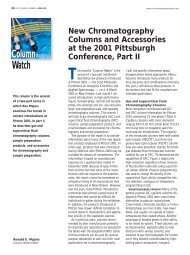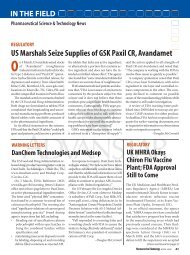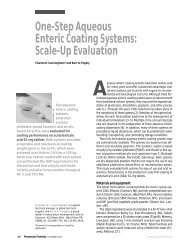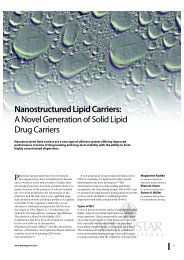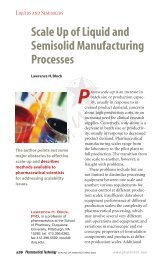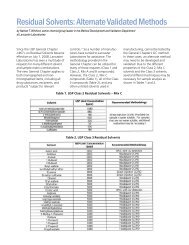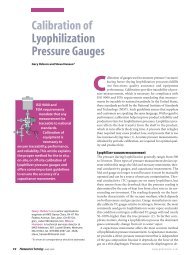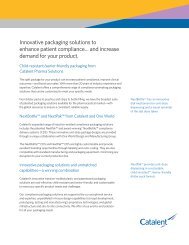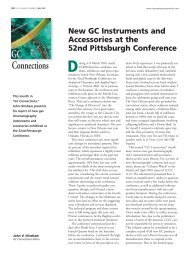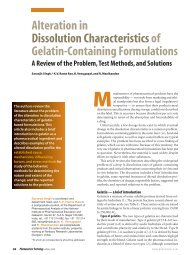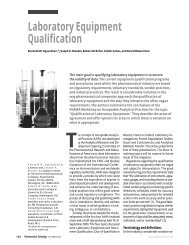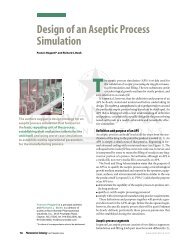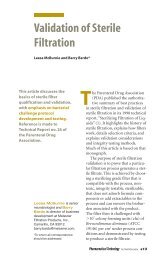The Role of the Column in Preparative HPLC - Chromatography ...
The Role of the Column in Preparative HPLC - Chromatography ...
The Role of the Column in Preparative HPLC - Chromatography ...
You also want an ePaper? Increase the reach of your titles
YUMPU automatically turns print PDFs into web optimized ePapers that Google loves.
416 LCGC NORTH AMERICA VOLUME 22 NUMBER 5 MAY 2004 www.chromatographyonl<strong>in</strong>e.com<br />
<strong>Column</strong><br />
Watch<br />
This discussion <strong>of</strong><br />
preparative<br />
chromatography focuses<br />
on <strong>the</strong> columns used <strong>in</strong><br />
preparative <strong>HPLC</strong>,<br />
<strong>in</strong>clud<strong>in</strong>g how to select<br />
<strong>the</strong> appropriate mode,<br />
mobile-phase system, and<br />
operat<strong>in</strong>g conditions.<br />
Ronald E. Majors<br />
<strong>Column</strong> Watch Editor<br />
<strong>The</strong> <strong>Role</strong> <strong>of</strong> <strong>the</strong> <strong>Column</strong> <strong>in</strong><br />
<strong>Preparative</strong> <strong>HPLC</strong><br />
In <strong>the</strong> course <strong>of</strong> writ<strong>in</strong>g this year’s<br />
Pittcon coverage <strong>of</strong> high performance<br />
liquid chromatography (<strong>HPLC</strong>)<br />
columns (1,2), I observed that large numbers<br />
<strong>of</strong> columns and pack<strong>in</strong>g materials<br />
designed for preparative LC were <strong>in</strong>troduced<br />
at <strong>the</strong> conference. I thought this<br />
might give me <strong>the</strong> opportunity to review<br />
some <strong>of</strong> <strong>the</strong> basics <strong>of</strong> preparative chromatography,<br />
emphasiz<strong>in</strong>g <strong>the</strong> role <strong>of</strong> <strong>the</strong><br />
column <strong>in</strong> its successful implementation.<br />
It <strong>of</strong>ten has been stated (or perhaps overstated)<br />
that <strong>the</strong> column is <strong>the</strong> heart <strong>of</strong> <strong>the</strong><br />
liquid chromatograph. Choice <strong>of</strong> <strong>the</strong> wrong<br />
column and mobile-phase conditions for<br />
<strong>the</strong> sample at hand can trivialize all <strong>of</strong> <strong>the</strong><br />
advantages <strong>of</strong> expensive, sophisticated<br />
<strong>in</strong>strumentation and data systems. In<br />
preparative chromatography, this statement<br />
also is true. Because one <strong>of</strong>ten is work<strong>in</strong>g<br />
with a sample that might have limited solubility<br />
<strong>in</strong> <strong>the</strong> <strong>in</strong>jection solvent or mobile<br />
phase, and <strong>in</strong>jections <strong>of</strong> large volumes <strong>of</strong><br />
sample (for <strong>in</strong>creased throughput) are used<br />
frequently, an unsuitable column–mobilephase<br />
comb<strong>in</strong>ation can be even more disastrous,<br />
with possible sample precipitation<br />
wreak<strong>in</strong>g havoc on expensive wide-bore<br />
preparative columns and <strong>in</strong>strumentation.<br />
In this article, I will explore <strong>the</strong> columns<br />
used <strong>in</strong> preparative <strong>HPLC</strong> — how to select<br />
<strong>the</strong> appropriate mode, mobile-phase system,<br />
and operat<strong>in</strong>g conditions. I will<br />
assume that <strong>the</strong> reader already has a familiarity<br />
with analytical <strong>HPLC</strong> method development<br />
and separation optimization.<br />
<strong>The</strong> def<strong>in</strong>ition <strong>of</strong> preparative chromatography<br />
always has been fuzzy and is dependent<br />
upon <strong>the</strong> eyes <strong>of</strong> <strong>the</strong> beholder because<br />
<strong>the</strong> mass <strong>of</strong> <strong>in</strong>jected or collected sample<br />
<strong>of</strong>ten is dependent upon <strong>the</strong> amount available,<br />
sample complexity, or <strong>in</strong>tended use.<br />
For some, a few micrograms <strong>of</strong> material are<br />
sufficient for fur<strong>the</strong>r characterization or<br />
use, while for o<strong>the</strong>rs, tens <strong>of</strong> grams represent<br />
preparative amounts. <strong>The</strong> purity<br />
requirement and sample throughput (that<br />
is, <strong>the</strong> amount <strong>of</strong> material or yield per unit<br />
time collected) also must be considered.<br />
Analytical separations <strong>of</strong>ten assume<br />
Langmuir-like iso<strong>the</strong>rms and that <strong>the</strong> resolution<br />
equation is obeyed strictly. In preparative<br />
<strong>HPLC</strong>, where columns are frequently<br />
(and sometimes heavily) overloaded, <strong>the</strong><br />
actual iso<strong>the</strong>rms and <strong>the</strong> commonly<br />
accepted relationships no longer apply<br />
quantitatively. For example, <strong>in</strong> analytical<br />
<strong>HPLC</strong>, a commonly accepted def<strong>in</strong>ition <strong>of</strong><br />
column capacity is <strong>the</strong> mass <strong>of</strong> sample<br />
<strong>in</strong>jected that causes a 10% decl<strong>in</strong>e <strong>in</strong> column<br />
efficiency. In preparative chromatography,<br />
column capacity is <strong>of</strong>ten not so precisely<br />
def<strong>in</strong>ed because <strong>the</strong> amount <strong>of</strong><br />
sample <strong>in</strong>jected could exceed this value by<br />
an order <strong>of</strong> magnitude. Instead, overload <strong>in</strong><br />
preparative LC is def<strong>in</strong>ed as load<strong>in</strong>g that no<br />
longer permits <strong>the</strong> isolation <strong>of</strong> product at<br />
<strong>the</strong> desired purity or recovery levels (3).<br />
<strong>Column</strong> capacity also must take <strong>in</strong>to<br />
account o<strong>the</strong>r molecules <strong>in</strong> <strong>the</strong> sample,<br />
<strong>in</strong>clud<strong>in</strong>g <strong>the</strong> matrix, because <strong>the</strong>se compete<br />
with <strong>the</strong> analytes <strong>of</strong> <strong>in</strong>terest for active<br />
sites. Remember, when we discuss capacity,<br />
we mean <strong>the</strong> sample capacity and not <strong>the</strong><br />
capacity factor, which is a measure <strong>of</strong> analyte<br />
retention. <strong>The</strong> goal <strong>of</strong> a preparative<br />
purification is <strong>the</strong> maximum production <strong>of</strong><br />
purified product per <strong>in</strong>jection.<br />
Basics <strong>of</strong> Scal<strong>in</strong>g Up from<br />
Analytical LC to <strong>Preparative</strong> LC<br />
Scale-up from analytical LC to preparativescale<br />
chromatography <strong>of</strong>ten is time-consum<strong>in</strong>g<br />
and wasteful <strong>of</strong> materials unless an<br />
optimized scale-up strategy is employed. As<br />
depicted <strong>in</strong> Figure 1, a recommended<br />
method-development strategy is to develop<br />
and optimize <strong>the</strong> <strong>in</strong>itial separation on an<br />
analytical size column, overload <strong>the</strong> column<br />
while ma<strong>in</strong>ta<strong>in</strong><strong>in</strong>g adequate separation <strong>of</strong><br />
components <strong>of</strong> <strong>in</strong>terest, <strong>the</strong>n scale-up<br />
accord<strong>in</strong>gly to a preparative column <strong>of</strong><br />
appropriate dimensions based upon <strong>the</strong><br />
amount <strong>of</strong> purified compound needed.<br />
Thus, <strong>the</strong> choice <strong>of</strong> analytical column <strong>of</strong>ten<br />
is dictated by <strong>the</strong> availability <strong>of</strong> preparative
418 LCGC NORTH AMERICA VOLUME 22 NUMBER 5 MAY 2004 www.chromatographyonl<strong>in</strong>e.com<br />
Figure 1: Method development strategy for scale-up.<br />
columns conta<strong>in</strong><strong>in</strong>g <strong>the</strong> same column-pack<strong>in</strong>g<br />
material, ei<strong>the</strong>r <strong>in</strong> prepacked columns<br />
or <strong>in</strong> bulk media that users can pack. <strong>The</strong>n,<br />
us<strong>in</strong>g <strong>the</strong> equations shown <strong>in</strong> Figure 2, <strong>the</strong><br />
scale-up should be l<strong>in</strong>ear with perhaps only<br />
m<strong>in</strong>or adjustments required to f<strong>in</strong>alize <strong>the</strong><br />
preparative method. It is highly recommended<br />
that one ensures that both analytical<br />
and preparative columns from <strong>the</strong> same<br />
l<strong>in</strong>e <strong>of</strong> pack<strong>in</strong>g material be readily available<br />
before beg<strong>in</strong>n<strong>in</strong>g <strong>the</strong> preparative method<br />
development and optimization process.<br />
Table I Guidel<strong>in</strong>e for capacity <strong>of</strong><br />
preparative LC columns<br />
<strong>Column</strong> i.d. a, 1.2 a. 1.5<br />
4.6-mm 2–3 mg 20–30 mg<br />
9.4 10–20 100–200<br />
21.2 50–200 500–2000<br />
raphy (IEC) sometimes are used for preparative<br />
scale-up and purification. A typical<br />
preparative use for SEC might be for <strong>the</strong><br />
elim<strong>in</strong>ation <strong>of</strong> high molecular weight compounds<br />
or for prote<strong>in</strong> purifications. <strong>The</strong><br />
IEC technique is used for <strong>the</strong> preparation<br />
<strong>of</strong> <strong>in</strong>organic or organic ionic compounds<br />
such as prote<strong>in</strong>s. Both techniques are used<br />
sometimes <strong>in</strong> conjunction with o<strong>the</strong>r<br />
preparative modes. Of course, chiral<br />
preparative separations can be achieved on<br />
preparative versions and such columns can<br />
be purchased, but <strong>the</strong> cost <strong>of</strong> such columns<br />
relegates <strong>the</strong>m to <strong>the</strong> specialty column category.<br />
Supercritical fluid chromatography<br />
has found use <strong>in</strong> large-scale purification <strong>of</strong><br />
enantiomeric materials.<br />
For decades, adsorption chromatography<br />
on silica gel or o<strong>the</strong>r liquid–solid media<br />
(such as alum<strong>in</strong>a and kieselguhr) was <strong>the</strong><br />
ma<strong>in</strong> technique for purification <strong>of</strong> a variety<br />
<strong>of</strong> syn<strong>the</strong>tic organic mixtures as well as<br />
o<strong>the</strong>r sample types. However, <strong>the</strong> overwhelm<strong>in</strong>g<br />
popularity <strong>of</strong> reversed-phase<br />
chromatography <strong>in</strong> <strong>the</strong> analytical world has<br />
shifted <strong>the</strong> emphasis to this mode <strong>of</strong> operation<br />
for preparative LC. Also, many analytical<br />
<strong>HPLC</strong> users are not familiar with <strong>the</strong><br />
pr<strong>in</strong>ciples <strong>of</strong> adsorption chromatography;<br />
<strong>the</strong>y are more comfortable with reversedphase<br />
chromatography and for this reason,<br />
tend to gravitate to it when fac<strong>in</strong>g a<br />
preparative need.<br />
Liquid–solid (and normal phase) <strong>HPLC</strong><br />
uses organic solvents that are more volatile<br />
compared with <strong>the</strong> aqueous-based solvent<br />
systems used <strong>in</strong> reversed-phase chromatography.<br />
In addition, normal-phase solvents<br />
Choos<strong>in</strong>g <strong>the</strong> Appropriate Mode<br />
and Stationary Phase <strong>in</strong><br />
<strong>Preparative</strong> <strong>Chromatography</strong><br />
In preparative scale-up, <strong>the</strong> same separation<br />
modes that were used <strong>in</strong> analytical-scale<br />
chromatography can be employed. However,<br />
due to cost and availability <strong>of</strong> high<br />
performance preparative pack<strong>in</strong>g materials,<br />
<strong>the</strong> cost <strong>of</strong> mobile phase and mobile-phase<br />
additives, <strong>the</strong> high throughput requirements,<br />
and <strong>the</strong> need to recover isolated<br />
fractions <strong>in</strong> a high purity state, users <strong>of</strong>ten<br />
limit <strong>the</strong>mselves to <strong>the</strong> more popular<br />
modes <strong>of</strong> adsorption and reversed-phase<br />
chromatography. Size-exclusion chromatography<br />
(SEC) and ion-exchange chromatoghave<br />
a higher solubility for many compounds,<br />
and reversed-phase chromatography<br />
<strong>of</strong>ten displays a lower sample capacity<br />
for compounds due to lower solubility. For<br />
compound recovery, <strong>the</strong> isolated fractions<br />
from a normal-phase separation can be<br />
recovered quickly by evaporation <strong>of</strong> <strong>the</strong><br />
volatile organic solvent. On <strong>the</strong> o<strong>the</strong>r hand,<br />
at <strong>the</strong> conclusion <strong>of</strong> reversed-phase chromatography<br />
purification, <strong>the</strong> collected<br />
solutes are <strong>in</strong> a predom<strong>in</strong>antly aqueous<br />
medium. <strong>The</strong> removal <strong>of</strong> <strong>the</strong> water to concentrate<br />
and recover <strong>the</strong> purified fraction<br />
might take much longer or necessitate additional<br />
isolation steps such as desalt<strong>in</strong>g or<br />
solid-phase extraction. <strong>The</strong> use <strong>of</strong> higher<br />
temperatures to evaporate aqueous media<br />
can stress <strong>the</strong> isolated drug or biomolecule<br />
or even destroy it dur<strong>in</strong>g <strong>the</strong> concentration<br />
process. Thus, it is important to test <strong>the</strong><br />
temperature stability dur<strong>in</strong>g <strong>the</strong> analyticalscale<br />
method development before scal<strong>in</strong>g<br />
up to preparative scale.<br />
One consideration <strong>in</strong> preparative chromatography<br />
that usually is <strong>of</strong> lower importance<br />
<strong>in</strong> analytical chromatography is <strong>the</strong><br />
sample capacity <strong>of</strong> <strong>the</strong> pack<strong>in</strong>g material.<br />
Because throughput is a primary criterion<br />
<strong>in</strong> preparative LC, columns with higher<br />
capacity can handle more material per<br />
<strong>in</strong>jection. For adsorption chromatography,<br />
<strong>the</strong> surface area <strong>of</strong> an adsorbent dictates <strong>the</strong><br />
capacity. A higher surface area sorbent will<br />
allow <strong>in</strong>jection <strong>of</strong> larger sample masses than<br />
a lower surface area sorbent. In reversedphase<br />
chromatography, <strong>in</strong> addition to solubility<br />
<strong>of</strong> <strong>the</strong> analyte, <strong>the</strong> bonded-phase coverage<br />
determ<strong>in</strong>es <strong>the</strong> sample capacity.<br />
Although one might th<strong>in</strong>k that <strong>the</strong> capacity<br />
<strong>of</strong> <strong>the</strong> reversed-phase chromatography<br />
media is dictated by <strong>the</strong> alkyl cha<strong>in</strong> length<br />
<strong>of</strong> <strong>the</strong> bonded phase (for example, C 18 versus<br />
C 4 ), it is more <strong>in</strong>fluenced by <strong>the</strong><br />
bonded-phase coverage.<br />
Surface coverage <strong>of</strong>ten is expressed as<br />
micromoles per meter squared. For a typical<br />
silica-gel pack<strong>in</strong>g, <strong>the</strong>re are roughly<br />
8 mmol/m 2 <strong>of</strong> surface silanols available for<br />
bond<strong>in</strong>g. Because <strong>in</strong> adsorption chromatography<br />
<strong>the</strong> silanol group is responsible for<br />
analyte retention, <strong>the</strong> larger <strong>the</strong> surface area<br />
is, <strong>the</strong> more silanols that are present and<br />
<strong>the</strong> greater <strong>the</strong> retention. In reversed-phase<br />
chromatography, <strong>the</strong> mechanism is<br />
hydrophobic <strong>in</strong>teraction between <strong>the</strong> alkyl<br />
and aryl groups on <strong>the</strong> analyte with <strong>the</strong><br />
bonded phase. For a typical monomeric<br />
C18 bonded phase, for steric reasons, <strong>the</strong><br />
bonded-phase coverage usually is <strong>in</strong> <strong>the</strong><br />
range <strong>of</strong> 2.5–3 mmol/m 2 . Due to its smaller<br />
footpr<strong>in</strong>t on <strong>the</strong> surface, a monomeric C8
420 LCGC NORTH AMERICA VOLUME 22 NUMBER 5 MAY 2004 www.chromatographyonl<strong>in</strong>e.com<br />
Figure 2: Calculations for scale-up method development.<br />
phase might have a slightly larger coverage<br />
and a C4 an even larger coverage still. So<br />
on some reversed-phase pack<strong>in</strong>gs, <strong>the</strong> coverage<br />
<strong>of</strong> a shorter cha<strong>in</strong> alkyl phase actually<br />
can exceed that <strong>of</strong> a C18 bonded phase.<br />
Thus, <strong>the</strong> amount <strong>of</strong> available carbon for<br />
<strong>the</strong> hydrophobic <strong>in</strong>teraction with <strong>the</strong> analyte<br />
actually might provide a better measure<br />
<strong>of</strong> surface coverage than <strong>the</strong> alkyl<br />
cha<strong>in</strong> length. Most manufacturers provide<br />
<strong>the</strong> level <strong>of</strong> carbon coverage for <strong>the</strong>ir particular<br />
reversed-phase pack<strong>in</strong>gs. In addition<br />
to bonded-phase density, <strong>the</strong> density <strong>of</strong> <strong>the</strong><br />
particles <strong>in</strong> <strong>the</strong> packed column also can<br />
affect <strong>the</strong> sample capacity.<br />
Resolution is seen as <strong>the</strong> most important<br />
factor <strong>in</strong> analytical chromatography and is<br />
equally important <strong>in</strong> preparative chromatography.<br />
However, because columns<br />
frequently are overloaded <strong>in</strong> preparative LC<br />
and peaks are broadened, <strong>the</strong> selectivity <strong>of</strong><br />
<strong>the</strong> separation <strong>of</strong>ten is a very important<br />
factor <strong>in</strong> successfully us<strong>in</strong>g preparative LC.<br />
If <strong>the</strong> selectivity between two sample components<br />
that are to be isolated is high, one<br />
can overload <strong>the</strong> column to a much greater<br />
extent than if <strong>the</strong> selectivity is low. Thus,<br />
choice <strong>of</strong> stationary phase can be critical to<br />
provid<strong>in</strong>g <strong>the</strong> best selectivity for <strong>the</strong> components<br />
<strong>of</strong> <strong>in</strong>terest. Table I provides some<br />
rough guidel<strong>in</strong>es on sample capacity for a<br />
typical reversed-phase column as a function<br />
<strong>of</strong> a (selectivity factor). <strong>The</strong> actual<br />
sample capacity for your <strong>in</strong>dividual sample<br />
components might have to be determ<strong>in</strong>ed<br />
by trial-and-error measurement.<br />
Particle Size and <strong>Column</strong><br />
Dimensions<br />
Particle size is an important parameter for<br />
analytical <strong>HPLC</strong>. Generally, smaller particle<br />
sizes allow greater efficiency and permit<br />
<strong>the</strong> use <strong>of</strong> shorter columns to <strong>in</strong>crease separation<br />
speed. In preparative chromatography,<br />
<strong>the</strong> particle size is important, but <strong>the</strong><br />
column <strong>of</strong>ten is used <strong>in</strong> an overloaded<br />
state, <strong>the</strong> smaller and more expensive particles<br />
<strong>of</strong> 1.8-, 3.0-, and 3.5-mm average<br />
diameters that are used <strong>in</strong> analytical<br />
columns generally are not used <strong>in</strong> largerscale<br />
preparative columns. If a sample is<br />
very complex with poor resolution (and<br />
selectivity) among compounds <strong>of</strong> <strong>in</strong>terest<br />
and overload<strong>in</strong>g sometimes is difficult,<br />
<strong>the</strong>n 5-mm particles frequently are used.<br />
For well-resolved samples, larger particles<br />
<strong>of</strong> 7 and 10 mm can be used. Sometimes,<br />
even larger particles are used, but a trade<strong>of</strong>f<br />
<strong>of</strong> yield, purity, and throughput must be<br />
achieved. Because pressure drop is <strong>in</strong>versely<br />
proportional to <strong>the</strong> particle diameter<br />
squared, larger particles give lower pressure<br />
drop, allow<strong>in</strong>g higher flow rates, which <strong>in</strong><br />
turn <strong>in</strong>creases <strong>the</strong> throughput <strong>of</strong> preparative<br />
columns. Generally, <strong>the</strong> cost <strong>of</strong> pack<strong>in</strong>g<br />
material is <strong>in</strong>versely proportional to<br />
particle size, so <strong>the</strong> larger particles usually<br />
Table II Typical operat<strong>in</strong>g conditions for columns <strong>of</strong> various dimensions<br />
Parameter<br />
<strong>Column</strong> Diameter*<br />
Length (cm) 4.6 mm 9.4 mm 21.2 mm 30 mm 50 mm<br />
5<br />
10<br />
15<br />
25<br />
1 mg 3–5 mg 30–50 mg 80–100 mg 250–300 mg<br />
4–6 15–20 80–90 200–250 500–700<br />
8–10 30–40 140–160 300–350 800–900<br />
12–15 50–60 200–250 475–525 1200–1400<br />
Injection volume (mL) 10–20 50–75 350–400 700–800 1500–2500<br />
Flow rate (mL/m<strong>in</strong>) † 1.0 4.2 21.2 42.5 118<br />
* Blue shaded area represents approximate sample mass that can be <strong>in</strong>jected onto a column <strong>of</strong> <strong>the</strong>se<br />
dimensions.<br />
† Flow rate required to keep l<strong>in</strong>ear velocity and separation time <strong>the</strong> same.
422 LCGC NORTH AMERICA VOLUME 22 NUMBER 5 MAY 2004 www.chromatographyonl<strong>in</strong>e.com<br />
Figure 3: Scale-up <strong>of</strong> a reversed-phase separation <strong>of</strong> two xanth<strong>in</strong>es. Shown are (a) analytical column<br />
separations and (b) <strong>the</strong> preparative separation result<strong>in</strong>g from scale-up calculations. (a) <strong>Column</strong>:<br />
150 mm 3 3 mm, 5-mm d p Zorbax SB-C18 (Agilent Technologies, Wilm<strong>in</strong>gton, Delaware);<br />
mobile phase: 90:10 (v/v) water–acetonitrile; flow rate: 0.6 mL/m<strong>in</strong>; detection: UV absorbance at<br />
270 nm; pathlength: 10 mm; temperature: ambient. (b) <strong>Column</strong>: 150 mm 3 21.2 mm, 5-mm d p Zorbax<br />
SB-C18; mobile phase: 90:10 (v/v) water–acetonitrile; flow rate: 25 mL/m<strong>in</strong>; detection: UV<br />
absorbance at 270 nm; pathlength: 3 mm; temperature: ambient.<br />
are less expensive than <strong>the</strong> smaller particles.<br />
However, <strong>the</strong> need for high purity for<br />
complex samples with poor resolution<br />
between <strong>the</strong> important analytes can require<br />
small-particle pack<strong>in</strong>gs.<br />
<strong>Column</strong> dimensions are dictated by <strong>the</strong><br />
amount <strong>of</strong> material per <strong>in</strong>jection that one<br />
desires to <strong>in</strong>ject. <strong>The</strong> amount <strong>of</strong> sample<br />
that can be <strong>in</strong>jected <strong>in</strong>creases with column<br />
<strong>in</strong>ternal diameter (and length), so us<strong>in</strong>g <strong>the</strong><br />
equations <strong>in</strong> Figure 2, one can calculate <strong>the</strong><br />
column diameter that fits <strong>the</strong> sample size<br />
required. Typically, 4.6-mm i.d. columns<br />
are used for small-scale preparative work,<br />
7.8-mm i.d. columns are for semipreparative<br />
work, and 21.2-mm i.d. columns are<br />
for larger scale preparative applications.<br />
<strong>Column</strong>s with 30-mm, 50-mm, and even<br />
greater <strong>in</strong>ternal diameters are available for<br />
even higher levels <strong>of</strong> scale-up. Beyond<br />
<strong>the</strong>se diameters, very large-scale preparative<br />
and process <strong>in</strong>struments capable <strong>of</strong><br />
extremely high flow rates (hundreds <strong>of</strong> milliliters<br />
per m<strong>in</strong>ute) might be required, and<br />
thus, have a higher degree <strong>of</strong> solvent usage.<br />
Amount <strong>of</strong> Sample Injected<br />
<strong>The</strong> amount (mass) <strong>of</strong> sample that can be<br />
<strong>in</strong>jected onto a column can vary widely<br />
based upon its solubility <strong>in</strong> <strong>the</strong> <strong>in</strong>jection<br />
solvent. A compromise must be made<br />
between <strong>the</strong> relative strength <strong>of</strong> <strong>the</strong> <strong>in</strong>jection<br />
solvent compared with <strong>the</strong> strength <strong>of</strong><br />
<strong>the</strong> chromatographic mobile phase. If <strong>the</strong><br />
<strong>in</strong>jection solvent is too strong relative to<br />
<strong>the</strong> chromatography mobile phase, <strong>the</strong> column<br />
can be volume overloaded and <strong>the</strong><br />
sample will spread out longitud<strong>in</strong>ally on<br />
<strong>the</strong> column at <strong>the</strong> po<strong>in</strong>t <strong>of</strong> <strong>in</strong>jection. In an<br />
isocratic mobile phase, this band spread<strong>in</strong>g<br />
might not be recoverable — bands will<br />
only get wider. In gradient chromatography,<br />
depend<strong>in</strong>g upon <strong>the</strong> <strong>in</strong>itial mobilephase<br />
strength, analytes can be refocused<br />
and still provide good efficiency. <strong>The</strong> best<br />
condition is when <strong>the</strong> <strong>in</strong>jection solvent is<br />
weaker than <strong>the</strong> chromatographic mobile<br />
phase, because <strong>the</strong> analyte is focused at <strong>the</strong><br />
head <strong>of</strong> <strong>the</strong> column. In some cases, however,<br />
<strong>the</strong>re can be stationary-phase overload<strong>in</strong>g<br />
with <strong>the</strong> <strong>in</strong>jected sample mass<br />
exceed<strong>in</strong>g <strong>the</strong> capacity <strong>of</strong> <strong>the</strong> <strong>in</strong>itial pack<strong>in</strong>g<br />
<strong>in</strong> <strong>the</strong> column. <strong>The</strong> concepts <strong>of</strong> volume<br />
overload<strong>in</strong>g and concentration overload<strong>in</strong>g<br />
are beyond <strong>the</strong> scope <strong>of</strong> this article.<br />
See references 3 and 4 for coverage.<br />
Table II gives a rough idea <strong>of</strong> <strong>the</strong> sample<br />
masses and volumes that might be <strong>in</strong>jected<br />
on reversed-phase columns <strong>of</strong> various<br />
dimensions. <strong>The</strong> masses were estimated for<br />
compounds with reasonable water solubility<br />
and only serve as guidel<strong>in</strong>es. <strong>The</strong>re are<br />
many experimental variables that affect <strong>the</strong><br />
mass that can be <strong>in</strong>jected. For compounds<br />
with relatively high k values display<strong>in</strong>g<br />
good resolution, for gradient elution separations,<br />
or for simple sample mixtures, one<br />
might be able to <strong>in</strong>ject larger amounts. If<br />
one is attempt<strong>in</strong>g to separate complex samples<br />
show<strong>in</strong>g poor resolution, compounds<br />
with low solubility <strong>in</strong> <strong>the</strong> <strong>in</strong>jection solvent,<br />
or if one is us<strong>in</strong>g a strong <strong>in</strong>jection solvent<br />
(relative to <strong>the</strong> mobile phase), <strong>the</strong>n much<br />
smaller amounts could be required to<br />
achieve adequate separation with <strong>the</strong><br />
absence <strong>of</strong> overload<strong>in</strong>g.<br />
Choice <strong>of</strong> Mobile Phase<br />
Often, a l<strong>in</strong>ear transfer <strong>of</strong> <strong>the</strong> chromatographic<br />
conditions can be achieved dur<strong>in</strong>g<br />
scale-up. <strong>The</strong> solvent system that will be<br />
used should be decided dur<strong>in</strong>g <strong>the</strong> analytical<br />
method development. Factors <strong>in</strong>fluenc<strong>in</strong>g<br />
solvent choice are stationary-phase and<br />
mobile-phase conditions with optimum<br />
selectivity for compounds <strong>of</strong> <strong>in</strong>terest; spectroscopic<br />
characteristics <strong>of</strong> mobile-phase<br />
solvents (that is, UV transparency, fluorescence<br />
properties, and mass spectroscopic<br />
compatibility); volatility for easy removal<br />
from isolated fractions; viscosity for low<br />
column back pressure; purity for low levels<br />
<strong>of</strong> nonvolatile contam<strong>in</strong>ants; good solubility<br />
properties for maximum sample loads;<br />
and cost <strong>of</strong> solvents employed.<br />
Not surpris<strong>in</strong>gly, solvent systems <strong>in</strong> normal<br />
phase chromatography <strong>of</strong>ten fulfill<br />
<strong>the</strong>se criteria, but never<strong>the</strong>less, preparative<br />
reversed-phase chromatography still commands<br />
<strong>the</strong> most attention. In analytical<br />
reversed-phase chromatography, nonvolatile<br />
buffer salts frequently are used to<br />
ensure proper pH and prevent tail<strong>in</strong>g and
424 LCGC NORTH AMERICA VOLUME 22 NUMBER 5 MAY 2004 www.chromatographyonl<strong>in</strong>e.com<br />
poor peak shape. In <strong>the</strong> development <strong>of</strong><br />
<strong>the</strong> analytical separation dest<strong>in</strong>ed for<br />
preparative scale-up, it is recommended<br />
that a volatile buffer or mobile-phase additive<br />
such as ammonium formate or ammonia<br />
be used for <strong>the</strong> <strong>in</strong>itial method because<br />
removal will be much easier <strong>in</strong> <strong>the</strong> f<strong>in</strong>al<br />
stages <strong>of</strong> <strong>the</strong> method. Also, if mass spectrometry<br />
(MS) is used for confirmation,<br />
such a system will be more compatible. If<br />
one already has an analytical method<br />
employ<strong>in</strong>g a nonvolatile buffer, a volatile<br />
buffer usually can be substituted with only<br />
m<strong>in</strong>or adjustments. Expect some differences<br />
<strong>in</strong> efficiency and selectivity from this<br />
substitution. A short list <strong>of</strong> recommended<br />
volatile buffer salts is <strong>in</strong>cluded <strong>in</strong> Table III.<br />
Because buffer volatility also is a primary<br />
concern with LC–MS <strong>in</strong>terfac<strong>in</strong>g, buffers<br />
used for preparative chromatography <strong>of</strong>ten<br />
are <strong>the</strong> same. For example, if us<strong>in</strong>g a phosphoric<br />
acid-based buffer at low pH, <strong>the</strong>n a<br />
trifluoroacetic acid or formic acid system<br />
can be used with preparative LC and<br />
LC–MS, although mass spectroscopists<br />
prefer formic acid because trifluoroacetic<br />
acid might suppress ionization <strong>of</strong> certa<strong>in</strong><br />
analytes <strong>in</strong> <strong>the</strong> MS ion source.<br />
Figure 4: Scale-up <strong>of</strong> a separation <strong>of</strong> three antibiotics. Shown are (a) <strong>the</strong> structures <strong>of</strong> <strong>the</strong> antibiotics,<br />
(b) scale-up separations on an analytical column, and (c) <strong>the</strong> result<strong>in</strong>g scaled preparative separation.<br />
(b) <strong>Column</strong>: 150 mm 3 4.6 mm, 5-mm d p Zorbax Eclipse XDB-C18; mobile phase: 65:35 (v/v)<br />
water–acetonitrile, both with 0.1% trifluoroacetic acid; flow rate: 1 mL/m<strong>in</strong>; detection: UV<br />
absorbance at 254 nm; <strong>in</strong>jection volume: 30 mL; temperature: ambient. (b) <strong>Column</strong>: 150 mm 3 21.2<br />
mm, 5-mm d p Zorbax Eclipse XDB-C18; mobile phase: 65:35 (v/v) water–acetonitrile, both with 0.1%<br />
trifluoroacetic acid; flow rate: 21.2 mL/m<strong>in</strong>; detection: UV absorbance at 254 nm; <strong>in</strong>jection volume:<br />
636 mL conta<strong>in</strong><strong>in</strong>g 2.2 mg <strong>of</strong> each antibiotic; temperature: ambient. <strong>The</strong> conditions for <strong>the</strong> <strong>in</strong>set<br />
analytical chromatogram <strong>in</strong> (c) were specified <strong>in</strong> Figure 3b. Peaks: 1 5 dicloxacillan, 2 5 cloxacillan,<br />
3 5 oxacillan.<br />
Examples <strong>of</strong> Scale-up from<br />
Analytical to <strong>Preparative</strong><br />
<strong>Chromatography</strong><br />
Xanth<strong>in</strong>es: <strong>The</strong> basic pr<strong>in</strong>ciple <strong>of</strong> scal<strong>in</strong>g<br />
up from an analytical chromatography column<br />
to a preparative column will be illustrated<br />
for <strong>the</strong> simple separation <strong>of</strong> two xanth<strong>in</strong>es:<br />
caffe<strong>in</strong>e and <strong>the</strong>ophyll<strong>in</strong>e. <strong>The</strong>se<br />
compounds easily can be separated us<strong>in</strong>g<br />
reversed-phase chromatography, as<br />
depicted <strong>in</strong> Figure 3a, which shows<br />
<strong>in</strong>creas<strong>in</strong>g amounts (from 0.025 mg each<br />
to 500 mg each) <strong>of</strong> <strong>the</strong> two xanth<strong>in</strong>es on a<br />
150 mm 3 3.0 mm Zorbax StableBond<br />
C18 analytical column. Note that <strong>the</strong><br />
smallest <strong>in</strong>jection mass <strong>of</strong> 0.025 mg cannot<br />
be observed <strong>in</strong> Figure 3 because full-scale<br />
absorbance is quite <strong>in</strong>sensitive <strong>The</strong> separation<br />
was performed isocratically at a flow<br />
rate <strong>of</strong> 0.6 mL/m<strong>in</strong> us<strong>in</strong>g a water–acetonitrile<br />
mobile-phase system without any<br />
additives. Note that as <strong>the</strong> <strong>in</strong>jected sample<br />
mass <strong>in</strong>creases, <strong>the</strong>re is a slight decrease <strong>in</strong><br />
<strong>the</strong> retention time <strong>of</strong> <strong>the</strong> two compounds,<br />
<strong>in</strong>dicat<strong>in</strong>g that some mass overload<strong>in</strong>g is<br />
occurr<strong>in</strong>g. Because a standard 10-mm<br />
pathlength UV flow cell was used at a<br />
wavelength <strong>of</strong> 270 nm, <strong>the</strong> detector electronics<br />
saturated at <strong>the</strong> higher sample<br />
amounts, result<strong>in</strong>g <strong>in</strong> <strong>the</strong> expected flattop<br />
peaks. Sometimes, one can tune <strong>the</strong> detector<br />
to a nonoptimum spectroscopic absorption<br />
wavelength to prevent electronic saturation<br />
and obta<strong>in</strong> better peak-shape characteristics.<br />
<strong>The</strong> two chromatographic peaks<br />
also were well resolved, even at <strong>the</strong> highest<br />
load<strong>in</strong>g, because <strong>the</strong>se two compounds displayed<br />
very good separation selectivity.<br />
Such good selectivity predicted good overload<strong>in</strong>g<br />
<strong>in</strong> <strong>the</strong> next stage <strong>of</strong> scale-up. Us<strong>in</strong>g<br />
<strong>the</strong> calculation formula from Figure 2, we<br />
next determ<strong>in</strong>ed <strong>the</strong> maximum mass that<br />
could be loaded on our preparative column<br />
that conta<strong>in</strong>ed <strong>the</strong> same pack<strong>in</strong>g material<br />
but with column dimensions <strong>of</strong> 150 mm<br />
3 21.2 mm, <strong>the</strong> same length as our analytical<br />
column. Figure 3b shows <strong>the</strong><br />
preparative chromatogram for a 25-mg<br />
<strong>in</strong>jection <strong>of</strong> each xanth<strong>in</strong>e onto <strong>the</strong> larger<br />
column but this time us<strong>in</strong>g a shorter pathlength<br />
preparative flow cell with <strong>the</strong> UV<br />
detector. This shorter pathlength was<br />
needed to prevent early detector electronics<br />
saturation and allowed us to observe <strong>the</strong><br />
eluted xanth<strong>in</strong>es, even at <strong>the</strong> 25-mg<br />
<strong>in</strong>jected level. Note that <strong>the</strong> flow rate was<br />
adjusted to 25 mL/m<strong>in</strong> <strong>in</strong>stead <strong>of</strong> <strong>the</strong> 30<br />
mL/m<strong>in</strong> that was calculated. <strong>The</strong> separa-
426 LCGC NORTH AMERICA VOLUME 22 NUMBER 5 MAY 2004 www.chromatographyonl<strong>in</strong>e.com<br />
Figure 5: <strong>Preparative</strong> separation <strong>of</strong> anthocyan<strong>in</strong>s <strong>in</strong> a blueberry extract (7). Shown are (a) anthocyan<strong>in</strong><br />
structures and (b) chromatograms from <strong>the</strong> separation. <strong>Column</strong>: 250 mm 3 21.2 mm, 7-mm<br />
d p PrepHT Zorbax StableBond-C18 column. Mobile phase A: 0.1% trifluoroacetic acid <strong>in</strong> water;<br />
mobile phase B: 0.1% trifluoroacetic acid <strong>in</strong> methanol; gradient: 23–25% B over 35 m<strong>in</strong>, 25–53.5%<br />
B over 50 m<strong>in</strong>; flow rate 21.2 mL/m<strong>in</strong>; detection: UV absorbance at 525 nm; sample: Sample: 46.1<br />
mg/mL total dissolved solids (~5-mg/mL anthocyan<strong>in</strong>s). Peaks: 1 5 deph<strong>in</strong><strong>in</strong>d<strong>in</strong>-3-galactoside, 2 5<br />
delph<strong>in</strong><strong>in</strong>d<strong>in</strong>-3-glucoside.<br />
tion <strong>of</strong> <strong>the</strong> two xanth<strong>in</strong>es was almost to <strong>the</strong><br />
basel<strong>in</strong>e, mean<strong>in</strong>g that both compounds<br />
could be collected at high purity.<br />
Antibiotics: Let us consider a separation<br />
that is a bit more complex: <strong>the</strong> scale-up <strong>of</strong><br />
three antibiotics — dicloxacillan, cloxacillan,<br />
and oxacillan — that also conta<strong>in</strong><br />
some low-level impurities. <strong>The</strong>ir structures<br />
are shown <strong>in</strong> Figure 4a. Us<strong>in</strong>g analytical<br />
columns, we first <strong>in</strong>vestigated four bondedphase<br />
options for optimum peak shape and<br />
maximum selectivity (5) and found <strong>the</strong><br />
best separation <strong>in</strong> <strong>the</strong> shortest time on an<br />
endcapped C18 column.<br />
Scal<strong>in</strong>g up on an analytical column<br />
ra<strong>the</strong>r than a preparative column saves<br />
Table III Common volatile buffers used <strong>in</strong> preparative <strong>HPLC</strong><br />
Buffer Salt<br />
pH Range<br />
Trifluoroacetate<br />
xx–1.5<br />
Ammonium formate 3.0–5.0<br />
Pyrid<strong>in</strong>ium formate 3.0–5.0<br />
Ammonium acetate 3.8–5.8<br />
Ammonium carbonate 5.5–7.5 9.3–11.3<br />
Ammonium hydroxide 8.3–10.3<br />
sample, solvent, and time. By <strong>in</strong>ject<strong>in</strong>g<br />
<strong>in</strong>creas<strong>in</strong>g amounts <strong>of</strong> sample onto <strong>the</strong><br />
analytical column, one quickly can determ<strong>in</strong>e<br />
<strong>the</strong> po<strong>in</strong>t where <strong>the</strong> overload beg<strong>in</strong>s<br />
to affect peak shape and resolution. Figure<br />
4b shows <strong>the</strong> <strong>in</strong>jection <strong>of</strong> <strong>in</strong>creas<strong>in</strong>g<br />
amounts <strong>of</strong> our three antibiotics onto a<br />
150 mm 3 4.6 mm analytical column.<br />
Note that as <strong>the</strong> mass <strong>in</strong>creases, <strong>the</strong>re is a<br />
po<strong>in</strong>t where peak overload beg<strong>in</strong>s to occur.<br />
At <strong>the</strong> overload po<strong>in</strong>t, peaks beg<strong>in</strong> to<br />
become nonsymmetrical and eventually<br />
can become very distorted, as evidenced by<br />
<strong>the</strong> uppermost chromatogram <strong>of</strong> Figure<br />
4b. <strong>The</strong>refore, when experiment<strong>in</strong>g with a<br />
larger column, <strong>in</strong> some cases, one may<br />
want to scale back somewhat on <strong>the</strong> calculated<br />
<strong>in</strong>jected sample mass to ma<strong>in</strong>ta<strong>in</strong><br />
good peak shape, resolution, and peak<br />
purity. On <strong>the</strong> o<strong>the</strong>r hand, to improve<br />
sample load and throughput, one might<br />
want to <strong>in</strong>crease <strong>the</strong> sample size and actually<br />
overload <strong>the</strong> column until peaks start<br />
to overlap and purity is compromised.<br />
In <strong>the</strong> case <strong>of</strong> <strong>the</strong> preparative scale-up,<br />
we used <strong>the</strong> preparative scale-up factors<br />
equivalent to <strong>the</strong> second chromatogram<br />
from <strong>the</strong> top <strong>in</strong> Figure 4b –– <strong>the</strong> mass that<br />
was <strong>in</strong>jected just before overload<strong>in</strong>g<br />
occurred on <strong>the</strong> analytical column. <strong>The</strong><br />
result<strong>in</strong>g scaled preparative separation is<br />
shown <strong>in</strong> Figure 4c. <strong>The</strong> flow rate used on<br />
this preparative column is 21.2 times faster<br />
that <strong>the</strong> flow rate used on <strong>the</strong> analytical<br />
column, and <strong>the</strong> amount <strong>in</strong>jected was also<br />
<strong>in</strong>creased by <strong>the</strong> same amount. On this<br />
larger bore column, 2.2 mg <strong>of</strong> each antibiotic<br />
could be isolated under nonoverloaded<br />
conditions. Thus, on <strong>the</strong> preparative column,<br />
<strong>the</strong> identical separation and analysis<br />
time <strong>of</strong> less than 9 m<strong>in</strong> was achieved as<br />
with <strong>the</strong> analytical column.<br />
Natural Products, Anthocyan<strong>in</strong>s:<br />
Anthocyan<strong>in</strong>s are complex mixtures <strong>of</strong> pigments<br />
found <strong>in</strong> fruits and o<strong>the</strong>r plant<br />
parts. <strong>The</strong>y are associated with <strong>the</strong> colored<br />
components <strong>of</strong> red grapes, various berries,<br />
and so on. <strong>The</strong>re is a great deal <strong>of</strong> <strong>in</strong>terest<br />
<strong>in</strong> anthocyan<strong>in</strong>s due to <strong>the</strong>ir antioxidant<br />
properties and potential health benefits. In<br />
nature, <strong>the</strong>y occur most <strong>of</strong>ten as glycosides<br />
and might be acetylated, which gives rise<br />
to very heterogeneous mixtures (Figure 5a).<br />
<strong>The</strong>y can be separated by reversed-phase<br />
chromatography us<strong>in</strong>g water (acidified<br />
with formic acid)–methanol gradients and<br />
detected <strong>in</strong> <strong>the</strong> visible region <strong>of</strong> <strong>the</strong> spectra<br />
due to <strong>the</strong>ir color.<br />
Anthocyan<strong>in</strong>s can be extracted from<br />
fruit matrices us<strong>in</strong>g 70% methanol <strong>in</strong><br />
water (6). Unfortunately, this high percentage<br />
<strong>of</strong> methanol can wreak havoc on <strong>the</strong><br />
chromatography if a large volume <strong>of</strong><br />
extract is <strong>in</strong>jected onto <strong>the</strong> column. To<br />
illustrate this effect, a commercial sample<br />
<strong>of</strong> blueberries was extracted us<strong>in</strong>g <strong>the</strong> standard<br />
method (6), and <strong>the</strong> extracts were<br />
<strong>in</strong>jected <strong>in</strong>to a 250 mm 3 21.2 mm<br />
preparative column. <strong>The</strong> effect <strong>of</strong> <strong>in</strong>jection<br />
volume can be seen clearly <strong>in</strong> Figure 5b,<br />
where volumes <strong>of</strong> extract (diluted 3:10) as<br />
large as 5 mL were <strong>in</strong>jected onto a preparative<br />
column. With <strong>the</strong> largest <strong>in</strong>jection volume,<br />
<strong>the</strong> front part <strong>of</strong> <strong>the</strong> chromatogram is<br />
affected by <strong>the</strong> methanol <strong>in</strong> <strong>the</strong> <strong>in</strong>jection<br />
solvent with peaks spread<strong>in</strong>g out and resolution<br />
lost, while <strong>the</strong> later peaks are unaf-
428 LCGC NORTH AMERICA VOLUME 22 NUMBER 5 MAY 2004 www.chromatographyonl<strong>in</strong>e.com<br />
fected because <strong>the</strong>ir capacity factors are<br />
quite high <strong>in</strong> <strong>the</strong> <strong>in</strong>itial mobile-phase composition.<br />
Never<strong>the</strong>less, fractions <strong>of</strong> <strong>the</strong> first<br />
two eluted anthocyan<strong>in</strong>s (identified as<br />
peaks 1 and 2 <strong>in</strong> <strong>the</strong> chromatogram <strong>of</strong> Figure<br />
5) were collected automatically from<br />
<strong>the</strong> preparative column and identified by<br />
<strong>the</strong>ir UV and mass spectra (7) as delph<strong>in</strong><strong>in</strong>d<strong>in</strong>-3-galactoside<br />
and delph<strong>in</strong><strong>in</strong>d<strong>in</strong>-<br />
3-glucoside, respectively. By re<strong>in</strong>jection<br />
onto an analytical column, <strong>the</strong>ir purities<br />
were determ<strong>in</strong>ed to be greater than 99%<br />
and greater than 97%, respectively.<br />
Successful Use <strong>of</strong> <strong>Preparative</strong><br />
<strong>Chromatography</strong><br />
Many <strong>of</strong> <strong>the</strong> factors <strong>in</strong> successful analytical<br />
<strong>HPLC</strong> are prevalent <strong>in</strong> preparative <strong>HPLC</strong><br />
also, but some are even more <strong>of</strong> a factor.<br />
Because samples <strong>in</strong> preparative applications<br />
<strong>of</strong>ten are crude mixtures, impurities can<br />
accumulate at <strong>the</strong> head <strong>of</strong> <strong>the</strong> column and,<br />
if not removed, can cause peak shape and<br />
retention time change. Sometimes accumulated<br />
impurities do not affect retention but<br />
can change <strong>the</strong> column pressure, so one<br />
must watch for <strong>in</strong>creased column pressure.<br />
It is a good idea to flush <strong>the</strong> column occasionally<br />
with <strong>in</strong>creas<strong>in</strong>gly stronger solvents<br />
to remove bound impurities (8). Build-up<br />
<strong>of</strong> material <strong>in</strong> a packed column occurs<br />
most frequently when <strong>the</strong> <strong>in</strong>jection solvent<br />
is weaker than <strong>the</strong> mobile phase and is<br />
especially noticeable when isocratic elution<br />
is used. <strong>The</strong> stronger solvent strength used<br />
<strong>in</strong> gradient elution tends to help with<br />
removal <strong>of</strong> strongly held impurities. Silicagel<br />
adsorbent tends to hold onto more<br />
polar analytes, especially basic compounds,<br />
while reversed-phase pack<strong>in</strong>gs tend to favor<br />
more hydrophobic impurities.<br />
Know<strong>in</strong>g <strong>the</strong> history <strong>of</strong> <strong>the</strong> preparative<br />
column is <strong>of</strong> utmost importance. Because<br />
impurities from previous samples can show<br />
up unexpectedly when new preparative<br />
separation conditions are developed, it is<br />
advisable to start with a fresh column, or if<br />
this is not feasible, it is recommended to<br />
go through a solvent wash<strong>in</strong>g procedure at<br />
<strong>the</strong> very least. Of course, if <strong>the</strong> cost <strong>of</strong> <strong>the</strong><br />
solvents required to regenerate <strong>the</strong> column<br />
is more than that <strong>of</strong> pack<strong>in</strong>g or column<br />
replacement, <strong>the</strong>n it makes sense to replace<br />
<strong>the</strong> pack<strong>in</strong>g or replace <strong>the</strong> column. For<br />
self-packed columns, unpack<strong>in</strong>g <strong>the</strong> column<br />
and externally clean<strong>in</strong>g <strong>the</strong> loose<br />
pack<strong>in</strong>g material might be easier than<br />
attempt<strong>in</strong>g to clean it <strong>in</strong> <strong>the</strong> packed column.<br />
Often, <strong>the</strong> first few centimeters <strong>of</strong> a<br />
column suffer <strong>the</strong> most contam<strong>in</strong>ation,<br />
and remov<strong>in</strong>g this material and replac<strong>in</strong>g it<br />
with fresh pack<strong>in</strong>g can be performed<br />
relatively easily.<br />
S<strong>in</strong>ce both adsorption and reversedphase<br />
th<strong>in</strong>-layer chromatography (TLC)<br />
plates are now available, dur<strong>in</strong>g method<br />
development and transfer to <strong>the</strong> preparative<br />
adsorption column, <strong>the</strong> use <strong>of</strong> TLC<br />
can be helpful for quickly optimiz<strong>in</strong>g <strong>the</strong><br />
mobile-phase composition, for not<strong>in</strong>g <strong>the</strong><br />
presence <strong>of</strong> strongly reta<strong>in</strong>ed compounds<br />
at <strong>the</strong> po<strong>in</strong>t <strong>of</strong> spott<strong>in</strong>g (equivalent to <strong>the</strong><br />
head <strong>of</strong> <strong>the</strong> packed bed <strong>in</strong> <strong>the</strong> preparative<br />
column), and for qualitatively monitor<strong>in</strong>g<br />
<strong>the</strong> purity <strong>of</strong> collected fractions. With<br />
TLC, one can get an idea if <strong>the</strong> collected<br />
fraction is fairly pure or if additional<br />
method development is required. Of<br />
course, analytical <strong>HPLC</strong> can be used, but<br />
one is never certa<strong>in</strong> <strong>of</strong> <strong>the</strong> presence <strong>of</strong><br />
strongly reta<strong>in</strong>ed compounds that can be<br />
slowly eluted from <strong>the</strong> column to contam<strong>in</strong>ate<br />
subsequent isolated fractions.<br />
Some special techniques for ensur<strong>in</strong>g<br />
purity <strong>in</strong> preparative chromatography that<br />
are not used <strong>in</strong> analytical liquid chromatography<br />
are heartcutt<strong>in</strong>g and recycle.<br />
In heartcutt<strong>in</strong>g, just <strong>the</strong> middle portion <strong>of</strong><br />
a peak <strong>of</strong> <strong>in</strong>terest is collected and those<br />
portions <strong>of</strong> <strong>the</strong> peak <strong>in</strong> which <strong>the</strong>re is possible<br />
overlap with o<strong>the</strong>r sample components<br />
are discarded or sent to waste. Of<br />
course, <strong>in</strong> heartcutt<strong>in</strong>g, we sacrifice yield<br />
for purity. In recycle preparative chromatography,<br />
<strong>the</strong> effective length <strong>of</strong> a column<br />
is <strong>in</strong>creased by re<strong>in</strong>ject<strong>in</strong>g <strong>the</strong> column<br />
effluent that conta<strong>in</strong>s partially separated<br />
compounds <strong>of</strong> <strong>in</strong>terest back <strong>in</strong>to <strong>the</strong> head<br />
<strong>of</strong> <strong>the</strong> column, sometimes several times.<br />
Such a technique can be performed manually<br />
by collect<strong>in</strong>g <strong>the</strong> fraction <strong>of</strong> <strong>in</strong>terest<br />
and re<strong>in</strong>ject<strong>in</strong>g it <strong>in</strong>to <strong>the</strong> column. In<br />
modern <strong>HPLC</strong>-based systems, recycl<strong>in</strong>g<br />
can be done automatically us<strong>in</strong>g <strong>the</strong> alternate<br />
column-switch<strong>in</strong>g technique. In <strong>the</strong><br />
latter technique, two preparative columns<br />
connected by multiport valves are used<br />
alternatively to effectively leng<strong>the</strong>n <strong>the</strong><br />
time that a series <strong>of</strong> unresolved compounds<br />
spends on <strong>the</strong> column. Details <strong>of</strong> <strong>the</strong>se<br />
special techniques are beyond <strong>the</strong> scope <strong>of</strong><br />
this article.<br />
Conclusions<br />
Fur<strong>the</strong>r <strong>in</strong>formation about preparative<br />
chromatography columns and proper usage<br />
can be found <strong>in</strong> reference books and<br />
reviews devoted to <strong>the</strong> pr<strong>in</strong>ciples and<br />
applications (3,4,9–12). Modern preparative<br />
<strong>in</strong>struments coupled to high-efficiency<br />
and high-throughput columns have made<br />
<strong>the</strong> job <strong>of</strong> purify<strong>in</strong>g impure substances<br />
much easier. UV-based and mass-based<br />
fraction collectors can selectively cut eluted<br />
peaks to <strong>of</strong>fer additional fractionation<br />
capability. <strong>The</strong> outlook for preparative<br />
chromatography looks bright, with rugged<br />
preparative columns that can withstand<br />
many <strong>in</strong>jections now <strong>the</strong> norm, and fur<strong>the</strong>r<br />
work <strong>in</strong> special preparative phases<br />
such as monoliths and high-capacity sorbents<br />
will cont<strong>in</strong>ue.<br />
References<br />
(1) R.E. Majors, LCGC 22(3), 230–242 (2004).<br />
(2) R.E. Majors, LCGC 22(4), 322–337 (2004).<br />
(3) <strong>Preparative</strong> Liquid <strong>Chromatography</strong>, vol. 38,<br />
B.A. Bidl<strong>in</strong>gmeyer, Ed., (Elsevier Scientific,<br />
New York, 1987).<br />
(4) L.R. Snyder, J.J. Kirkland, and J.L. Glajch,<br />
Practical <strong>HPLC</strong> Method Development, 2nd ed.<br />
(Wiley & Sons, New York, 1997), pp. 50–56.<br />
(5) W. Long and R. Majors, “<strong>Preparative</strong> <strong>HPLC</strong><br />
Scale-Up <strong>of</strong> Antibiotics,” Application Note,<br />
Agilent Technologies, Inc., Wilm<strong>in</strong>gton,<br />
Delaware, February 2004.<br />
(6) W. Kalt, J.E. McDonald, R.D. Ricker, and<br />
X.Lu, Can. J. Plant Sci. 79, 617–623 (1999).<br />
(7) Clifford Woodward, “Scale-Up <strong>of</strong> Anthocyan<strong>in</strong><br />
Separations and Re-Analysis <strong>of</strong> Collected Fractions<br />
on an Agilent Prep-C18 <strong>Column</strong>” Application<br />
Note, Agilent Technologies, Inc., Wilm<strong>in</strong>gton,<br />
Delaware, February 2004.<br />
(8) R.E. Majors, LCGC 21(1), 19–26 (2003).<br />
(9) R.P.W. Scott, <strong>Preparative</strong> <strong>Chromatography</strong>,<br />
Chrom-Ed Book Series, [Onl<strong>in</strong>e] available:<br />
http://www.library4science.com/.<br />
(10) <strong>Preparative</strong>-Scale <strong>Chromatography</strong>, E. Grushka,<br />
Ed., (Marcel Dekker, New York, 1988).<br />
(11) “Scale-Up and Optimization <strong>in</strong> <strong>Preparative</strong><br />
<strong>Chromatography</strong>: Pr<strong>in</strong>ciples and Biopharmaceutical<br />
Applications,” Chromatographic Science,<br />
vol. 88, A.S. Rathore, Ed., (Marcel Dekker,<br />
New York, 2003).<br />
(12) <strong>Preparative</strong> and Production Scale <strong>Chromatography</strong>,<br />
G. Ganetsos and P.E. Barker, Eds., (Marcel<br />
Dekker, New York, 1992).<br />
Ronald E. Majors<br />
“<strong>Column</strong> Watch”<br />
Editor Ronald E.<br />
Majors is bus<strong>in</strong>ess<br />
development manager,<br />
Consumables<br />
and Accessories Bus<strong>in</strong>ess<br />
Unit, Agilent<br />
Technologies, Wilm<strong>in</strong>gton,<br />
Delaware,<br />
and is a member <strong>of</strong><br />
LCGC’s editorial advisory board. Direct correspondence<br />
about this column to “Sample Prep<br />
Perspectives,” LCGC, Woodbridge Corporate<br />
Plaza, 485 Route 1 South, Build<strong>in</strong>g F, First<br />
Floor, Isel<strong>in</strong>, NJ 08830, e-mail lcgcedit@lcgcmag.com.



